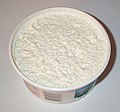Cottage cheese
Cottage cheese is a type of cheese that is known for its distinct curdled appearance and mild flavor. It is a fresh cheese product, meaning it does not undergo an aging or ripening process to develop flavor.
History[edit]
The origins of cottage cheese can be traced back to ancient times, where it was made as a way to utilize leftover milk. The name "cottage cheese" is believed to have originated in the 18th century when the cheese was made in cottages from any milk left over after making butter.
Production[edit]
Cottage cheese is made from the curds of cow's milk, either whole, part-skimmed or skimmed. It is typically washed to remove the acid and leave a sweet taste. It is then drained but not pressed, so some whey remains and the individual curds remain loose. The curd is usually washed to remove acidity, giving sweet cottage cheese. It is also available in creamed, whipped, and lactose-free varieties.
Nutritional Value[edit]
Cottage cheese is a rich source of protein, calcium, and vitamin B12. It is also low in fat and calories, making it a popular choice for those following a healthy diet or weight loss plan.
Uses[edit]
Cottage cheese can be eaten in a variety of ways. It is often consumed on its own or with fruit and sugar, salt and pepper, or other seasonings. It can also be used in cooking and baking, and is a common ingredient in dishes such as lasagna, salads, and pancakes.
See Also[edit]
-
Cottage cheese in a bowl
-
Cottage cheese draining in cheesecloth
-
World War I era cottage cheese
-
Close-up of cottage cheese
-
Cottage cheese and kabanos breakfast
Ad. Transform your life with W8MD's Budget GLP-1 injections from $75


W8MD offers a medical weight loss program to lose weight in Philadelphia. Our physician-supervised medical weight loss provides:
- Weight loss injections in NYC (generic and brand names):
- Zepbound / Mounjaro, Wegovy / Ozempic, Saxenda
- Most insurances accepted or discounted self-pay rates. We will obtain insurance prior authorizations if needed.
- Generic GLP1 weight loss injections from $75 for the starting dose.
- Also offer prescription weight loss medications including Phentermine, Qsymia, Diethylpropion, Contrave etc.
NYC weight loss doctor appointmentsNYC weight loss doctor appointments
Start your NYC weight loss journey today at our NYC medical weight loss and Philadelphia medical weight loss clinics.
- Call 718-946-5500 to lose weight in NYC or for medical weight loss in Philadelphia 215-676-2334.
- Tags:NYC medical weight loss, Philadelphia lose weight Zepbound NYC, Budget GLP1 weight loss injections, Wegovy Philadelphia, Wegovy NYC, Philadelphia medical weight loss, Brookly weight loss and Wegovy NYC
|
WikiMD's Wellness Encyclopedia |
| Let Food Be Thy Medicine Medicine Thy Food - Hippocrates |
Medical Disclaimer: WikiMD is not a substitute for professional medical advice. The information on WikiMD is provided as an information resource only, may be incorrect, outdated or misleading, and is not to be used or relied on for any diagnostic or treatment purposes. Please consult your health care provider before making any healthcare decisions or for guidance about a specific medical condition. WikiMD expressly disclaims responsibility, and shall have no liability, for any damages, loss, injury, or liability whatsoever suffered as a result of your reliance on the information contained in this site. By visiting this site you agree to the foregoing terms and conditions, which may from time to time be changed or supplemented by WikiMD. If you do not agree to the foregoing terms and conditions, you should not enter or use this site. See full disclaimer.
Credits:Most images are courtesy of Wikimedia commons, and templates, categories Wikipedia, licensed under CC BY SA or similar.
Translate this page: - East Asian
中文,
日本,
한국어,
South Asian
हिन्दी,
தமிழ்,
తెలుగు,
Urdu,
ಕನ್ನಡ,
Southeast Asian
Indonesian,
Vietnamese,
Thai,
မြန်မာဘာသာ,
বাংলা
European
español,
Deutsch,
français,
Greek,
português do Brasil,
polski,
română,
русский,
Nederlands,
norsk,
svenska,
suomi,
Italian
Middle Eastern & African
عربى,
Turkish,
Persian,
Hebrew,
Afrikaans,
isiZulu,
Kiswahili,
Other
Bulgarian,
Hungarian,
Czech,
Swedish,
മലയാളം,
मराठी,
ਪੰਜਾਬੀ,
ગુજરાતી,
Portuguese,
Ukrainian





